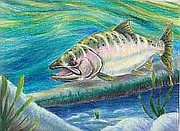State fish art contest deadline March 31
Herald Columnist | Hagadone News Network | UPDATED 10 years, 9 months AGO
Heads up educators - the State Fish Art Contest deadline is March 31. This allows three weeks to pass along the information about the contest to your students.
This is a contest which should be of interest to many Columbia Basin students and teachers. It is a great chance to discuss fish species and their habitat.
The steps to enter the contest include: Studying the fish and their aquatic environment. Create a 9- by 12-inch art illustration. Write on one side of one page a paper about the chosen fish species, its behavior and habitat, along with any conservation issues.
The art subject must be a fish from the state fish list, but it doesn't need to be from the state where the student resides. Washington's state fish is the steelhead, Idaho has the cutthroat trout and Oregon's state fish is the chinook salmon.
The contest is open, worldwide, to all children in grades K through 12 in any public, private or home-school setting. Also eligible are any youth groups, after-school program, youth camp, scout troop, art class or individual children who want to enter. The entries are grouped into four categories: Grades K-3, 4-6, 7-9 and 10-12.
There must be an adult who reads, agrees to the rules and signs the entry form. Only one entry per child will be accepted.
Other rules include: "The artwork must depict any officially designated state-fish. The fish must be depicted in its natural habitat.
"All artwork should be the student's original, hand-done creation. Photographs and computer-generated artwork will not be accepted.
"All artwork should be horizontal, 9-by 12-inch without a mat, frame or border. Almost any art medium is allowed, including, but not limited to: oils, scratch board, pointillism, chalk, pastels, charcoal, colored pencil, acrylics, dry brush, watercolor, crosshatch, lead, collage, linoleum printing, tempera and crayon. Spray chalk and pastel entries to eliminate scuffing and smudging. A loose cover sheet may be laid over the face for protection during shipping. Artwork should not exceed 1/4 inch in total thickness.
"Artwork should not have the artist's signature, initials or name on front. Any artwork with such identifying characteristics will be disqualified and eliminated from the competition.
"Use a clear glue stick to affix your completed entry form to the back of the artwork. Do not staple, paperclip or tape the entry form as it will most likely damage the artwork.
"The written words may be an essay, story, poem or other creative form. It should be no longer than one side of one page. It should be in the student's own words and relate specifically to their chosen state-fish, its habitat, behavior, or efforts to conserve it."
The judges are looking for a personal understanding or connection to the fish, not information copied or cut and pasted from research pages.
The written work must include the student's name, grade and state on the back. Submit the written work with the artwork, but do not attach it, as it will be judged separately.
Take advantage of this chance for the youngsters you know. Remember, even if an entire class doesn't participate, an individual student is eligible. These young artists simply need to be made aware of the opportunity.
ARTICLES BY HERALD COLUMNIST

It began 25 years ago, but who's counting
Feb. 13, 1991 was a special day for me. The first weekly outdoors column began on this day with my name on it. Forgive me, as I puff my chest a bit, but 52 columns a year for 25 years comes out to an even 1,300.

Relocation camp life not all bad for Mae Higashiyama
Bits and Pieces

I'm blaming Papa Joe Wiggs and Ted Nugent
The mission involved hazing pesky elk from certain orchards in an area south of Wenatchee. These critters can cause thousands of dollars worth of damage if not trained to stay away.



